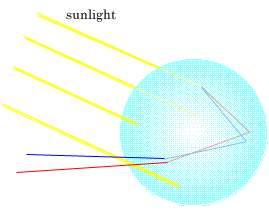
Somewhere...Over the Rainbow
How much light does each raindrop contribute to our rainbow? Recall from our experiment what the spectrum from our "mock raindrop" (the round flask) looked like. Why was it a complete circle around the flask? The light wasn't only shining on one little area of the raindrop: the whole front side was illuminated by the sun. We had white light shining on the left side and colored light emerging on the right side.

Similarly, we had white light shining on the right side and exiting as colored light on the left side of the raindrop. Actually, this was happening at every point on the sunward side of the raindrop. The result? We see a circle of light created by the incoming parallel light beams reflecting and refracting through a spherical surface.
How does this apply to a big rainbow with many raindrops?
Each raindrop is emitting the spectrum of colors, but surely a normal rainbow is far too large to be created by just one raindrop! We find that we are seeing only one color (indeed, only one tiny beam of light!) from each raindrop. In looking at a rainbow, we must be seeing the refracted light contributed from many raindrops. As it turns out, the raindrops lower in the sky contribute blue and green light; the drops higher in the sky contribute red and yellow light.

So if a single raindrop doesn't make a rainbow, how do we get the "bow" from many raindrops?
The Antisolar Point
If we look at the ground on sunny day, the shadow of our head marks the point called the antisolar point, 180° away from the sun. If the sun is in the sky, the antisolar point is below the horizon. If the sun has set, the antisolar point is above the horizon.

What does this have to do with rainbows? The antisolar point tells us where we can expect a rainbow to form, since the colored light from the raindrops exit those raindrops at specific angles that we can measure with respect to the antisolar point.
In other words, any rainbow we see in the sky is due to the raindrops 40.6° - 42° from the antisolar point reflecting colored light into our eyes.
Continue to the 4th Part of the Rainbow Readings
Page authored by the ACEPT
W3 Group
Department of Physics and
Astronomy, Arizona State University,
Tempe, AZ 85287-1504
Copyright © 1995-2000 Arizona Board of Regents. All rights reserved.